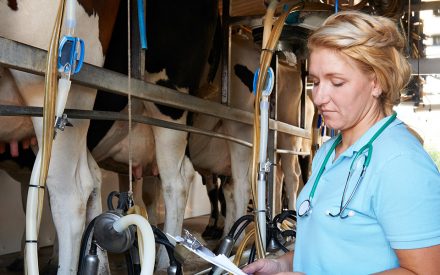Used extensively as a source of nitrogen fertilizer due to its relative ease of application and wide availability, the obvious downside of anhydrous ammonia use is the serious hazard it presents to workers during transfer and application.
The word “anhydrous” comes from the Greek, meaning “without water.” Because of the chemical’s strong affinity for water, upon contact, living tissue is dehydrated quickly and cells are destroyed. Moist parts of the body are at greatest risk, including eyes, ears, nose, throat and lungs. Even with an incidental spray or splash, body tissue can quickly receive severe chemical burns.
Under normal air pressure and temperatures, anhydrous ammonia is a colorless gas with a strong, distinctive odor. When it’s used on farms, however, it is stored as a pressurized liquid. Exposure incidents are most commonly from accidental release. These accidents happen most often during transfer from nurse tanks to applicators, from equipment failures (valves, quick-couplers, hoses), or during transport or application in the field.
First aid for victims requires flushing with large quantities of water, but due to its use far and wide from the farmstead, large quantities of clean water may not be readily available. Remote rural application injuries also create challenges, as medical help for burn victims may be many miles away. Vehicles should carry at least 5 gallons of water for emergency use. Water should be changed frequently, as open pails can absorb ammonia from the environment.
The hazards of handling anhydrous ammonia have been documented and discussed widely in farm publications, extension classes and industry seminars for many years. We’ve known about the serious and debilitating nature of these injuries for decades, since anhydrous ammonia first became commercially available to farms in the 1940 to ’50s. So that begs the question, “Why are farm workers still getting hurt from anhydrous ammonia?” Here are a couple of potential factors.
Reluctance to use personal protective equipment (PPE)
The recommendations for worker protection while using anhydrous ammonia are well documented. It is important to wear tight-fitting, chemical-proof goggles when handling ammonia. Regular glasses provide no protection. Another option is to wear an approved full-face respirator with ammonia cartridges that combines eye and lung protection. Never wear contact lenses when working with ammonia, as it can get into the lens and cause permanent eye damage before the lens can be removed.
Rubber gloves that are impervious to ammonia are required. The gloves should have an extended cuff that can be turned down to prevent the chemical from running down your sleeve when your arms are raised. Long pants and long-sleeved shirts are also required, with non-porous aprons and sleeves a good idea.
Despite the repeated warnings, unfortunately, PPE usage remains low. While the required safety equipment is widely available, and typically employer-provided, why are workers reluctant to use it?
1. Often PPE is viewed as uncomfortable. Goggles fog up (particularly non-vented) and can reduce vision. Gloves can feel awkward and limit dexterity. Warm spring days may make PPE hot and uncomfortable to wear.
2. Fit can be a challenge. Farm-provided PPE may not be the right size for varying-sized workers. Female employees, in particular, may struggle to find PPE that fits.
Additionally, farm leaders may encounter complaints. Obstacles commonly expressed by workers include:
- “I’ve done this for years; I know what I’m doing.”
- “This will just take a minute; I don’t have time to put this gear on.”
- “I look like an idiot when I’m wearing this stuff.”
Despite some inevitable pushback, it’s important to make PPE use a requirement, not a suggestion. It’s important for farm leaders to be “champions” for the use of PPE. Leading by example is critical for safe practices to be accepted. If workers see their bosses cutting corners on PPE use, it will be very difficult to build compliance.
Letting employees select sizing will also help. A little pre-planning will be necessary to make sure PPE fits properly before the application starts in the field. Getting your team involved in packing up PPE for the day’s application jobsite will also reinforce its importance.
Ineffective safety training
Another factor that puts employees at risk is ineffective (or sometimes nonexistent) safety training. Reinforcing safe practices for employees is vitally important. But unfortunately, sometimes our farm safety training efforts miss their mark. Often, they are viewed by both employees and leaders as an afterthought – or maybe even an obstacle to getting work done. If farm managers aren’t committed to serious discussions of the potential risks, workers are unlikely to take the matter seriously.
When training sessions are provided, they are often “speaker-dominated,” whether in-person or via video, without a lot of consideration for differing adult learning styles, comprehension levels or potential language barriers. Many times, they lack learner interaction or follow-up reinforcement.
In many cases, farms may use videos as their “go-to” training method because of ease of use and availability. While there are many good video resources available on safe use of anhydrous ammonia and other farm chemicals, training retention rates may be disappointingly low without any group discussion or activities to reinforce the information presented.
Research shows we can retain approximately 10% of what we see, 30% to 40% of what we see and hear, and 90% of what we see, hear and do. From this, we can see why simply showing a video may fall short. Adding activities and group interaction will help to reach those hands-on learners.
For farms with employees whose first language is not English, the challenge is compounded. It’s important to consider language comprehension when delivering safety training to your team.
Additional tips to improve your safety trainings:
- Make it relevant. Use real on-farm examples and specific examples your team can relate to.
- Encourage active participation. Get your employees up, out of their chairs and involved in the learning process. While interactive learning will take more prep up-front, the impact will be more lasting.
- Consider varying experience levels and backgrounds. Know your team. You may need to approach training differently with employees who have many years of experience versus new hires. Be careful about making assumptions that workers are knowledgeable from employment on other farms. Handling ammonia is a specialized skill they may not have had experience with.
- Practice makes perfect. Reinforce the training with quick reminders at morning briefings, break room signs or your farm newsletter. It may feel redundant to the trainer, but reinforcement is a key to retention, particularly for tasks that may only be performed seasonally.
While anhydrous ammonia continues to be one of the most dangerous chemicals handled on the farm, it can be handled safely when proper procedures are followed. Be a champion for anhydrous safety on your farm. Make sure you wear PPE and require your team to do the same.
Review your training program and make sure you’re reaching all employees in the way they learn best. By following recommended procedures, you can reduce the chance of having an anhydrous ammonia accident on your farm.
This article originally appeared in Progressive Forage Published on 31 March 2022.

 A culture of ‘farm safety’ starts with a well-written policy
A culture of ‘farm safety’ starts with a well-written policy Does Your Farm's Culture Reflect Who You Want to Be as An Employer?
Does Your Farm's Culture Reflect Who You Want to Be as An Employer? Effective Farm Safety Training Starts with a Purpose
Effective Farm Safety Training Starts with a Purpose Understanding the Total Compensation Statement Benefits Everyone
Understanding the Total Compensation Statement Benefits Everyone


